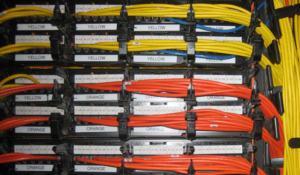 If ‘cabling nightmare’ befits your comms room, this one’s for you!
If ‘cabling nightmare’ befits your comms room, this one’s for you!
Having landed here, it’s likely that your comms room at work is looking like a mass of crazy cabling than the organised bliss above. It’s the core of your network but it’s not your core business, so if you’re not sure where to start, start here! It’s time to get yourself a patch panel and data cabinet to blitz this headache!
Sounds simple, and it is! You (or your installer) should rackmount all of your switches neatly in one cabinet and organise the cabling through a patch panel in order to bring clarity to your network. When it’s done, you’ll know instantly what’s on the other end of a cable if you need to unplug it.
What is a patch panel?
A patch panel is a termination point for all the cabling coming from the data ports around your building. A patch panel is neatly rackmounted in a data cabinet and is designed with a clear labelling system for complete clarity.
How does a patch panel work?
To best understand how it works, we can liken a patch panel to the old-fashioned telephone switchboard. The operator used to patch one caller through to another using cables on the switchboard to connect the two people’s telephones. Here, you patch devices through to eachother via patch cables on the patch panel, to connect them to the Internet via your switch and router.
How to use a patch panel
A patch panel has punchdown blocks at the back, and Ethernet ports at the front. The punchdown blocks are there to connect each run of Ethernet cabling into one central place. Once the wiring is neatly terminated it does not need to be altered from this point on. The cables are ready and waiting on the panel, to be patched into from the core switch, thus providing an Internet connection.
In front of each cable that’s been punched in, simply plug in a short patch cable from the main switch in the cabinet. Now, all the ports around the office building have an Internet connection for your network devices to plug into.
Colour-coded cables
For a truly professional job, order different coloured patch cables to use between your switch and the patch panel. Choose several colours to represent the different types of network traffic that your business uses, such as yellow for voice, orange for data, and perhaps blue for AV. Now the cabling will be even easier to work with.
Naming your uplink ports
Around the premises, a unique number must be physically marked on each of the main ports. i.e the ones housing a cable which links back to the data cabinet. Let’s assume that in the meeting room, you have a a floor socket with two Ethernet ports. One of the ports is connected to a 5 port switch for the connected devices. The unique numbers will need to be assigned to the two Ethernet ports in the floor socket, not to the ports on the switch. (The ports on the switch are irrelevant for this exercise as they don’t directly link back to the data cabinet). Note down all the unique numbers as you continue naming the main ports throughout the business.
Future-proofed
For any spare ports that aren’t in use, it’s still good practice to run a cable down to the data cabinet, so that they’re ready to use when you need them. Great for maintaining the smooth-running of your business when new staff members need a workstation setting up swiftly, or you need to move devices around the office.
Labelling the patch panel
For each port on the patch panel, write a logical name that corresponds to the location of the cable. For example, the ‘Meeting Room port 1’ on your list, might have a label name of ‘MEET-P1‘ on the patch panel. Now, when looking at your comms cabinet, if you’re ever contemplating any alterations to the network setup, you’ll be able to see at a glance, which locations would lose a connection if a cable were pulled.
Keeping a log
Once you’ve devised a system that’s logical for the layout of your business, document it properly, print it out and keep an up-to-date copy on the inside of the data cabinet door for ease of reference for you/your network installer.
If you’d like to speak to a networking expert to source the kit you’ll need to bring this level of organisation to your network, please call us on the number below. We look forward to helping you.

